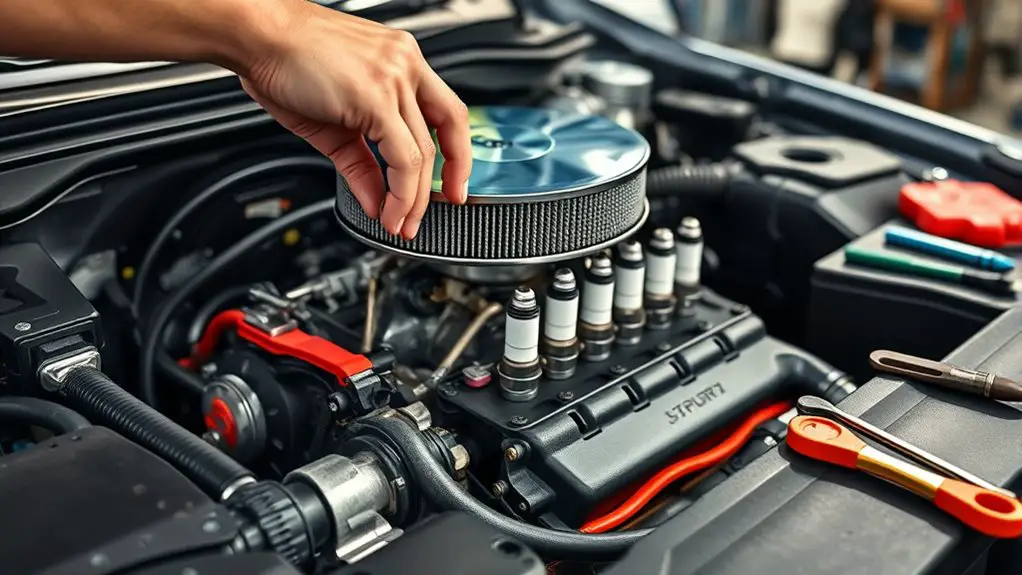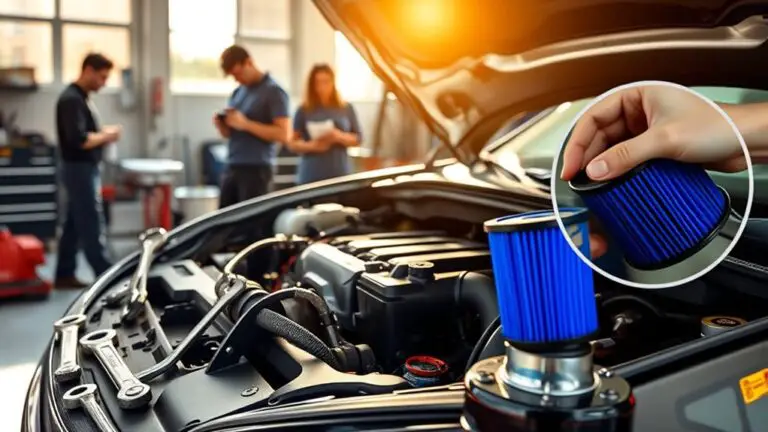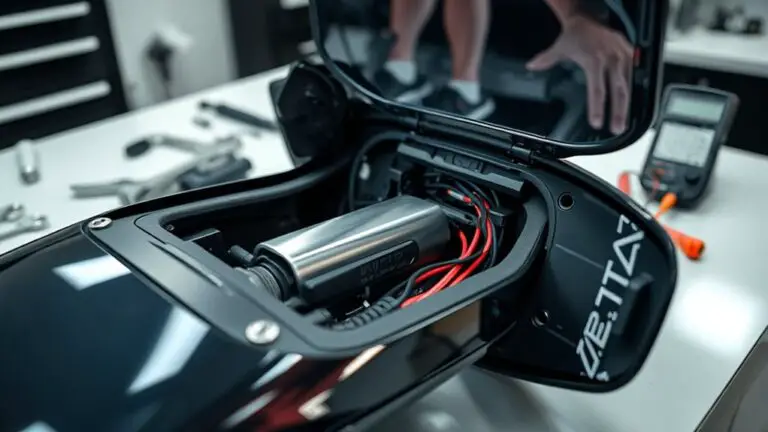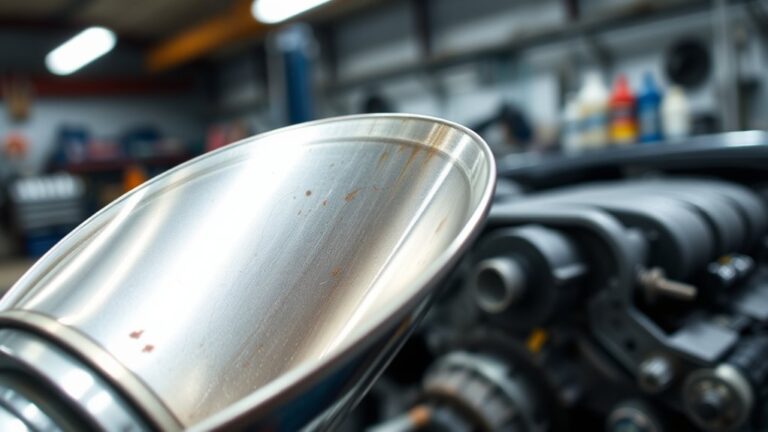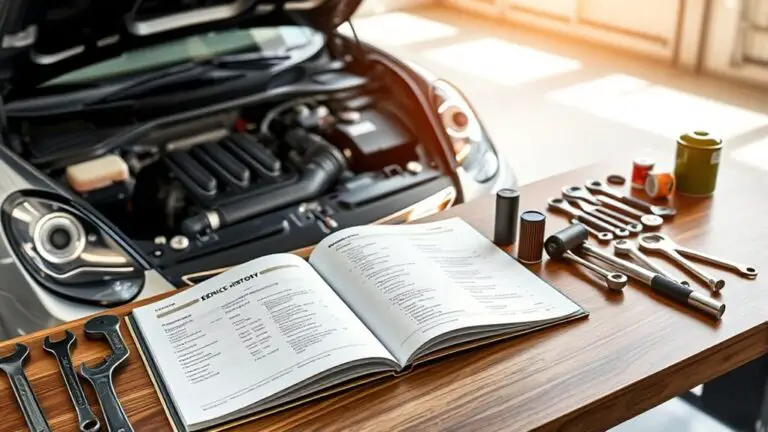Preventive Maintenance to Maintain Fuel Efficiency
Regular oil changes and filter care keep your engine running smoothly, minimizing friction and preserving efficiency. Pair this with air-filter checks to maintain optimum airflow, and monitor tire pressure, alignment, and tread for consistent rolling resistance. Don’t neglect spark plugs and the ignition system, which affect combustion efficiency. Regular coolant and fluid checks prevent overheating and maintain performance. Track driving habits and identify upgrades that boost efficiency. If you keep at this, you’ll uncover more actionable steps soon.
Regular Oil Changes and Filter Care
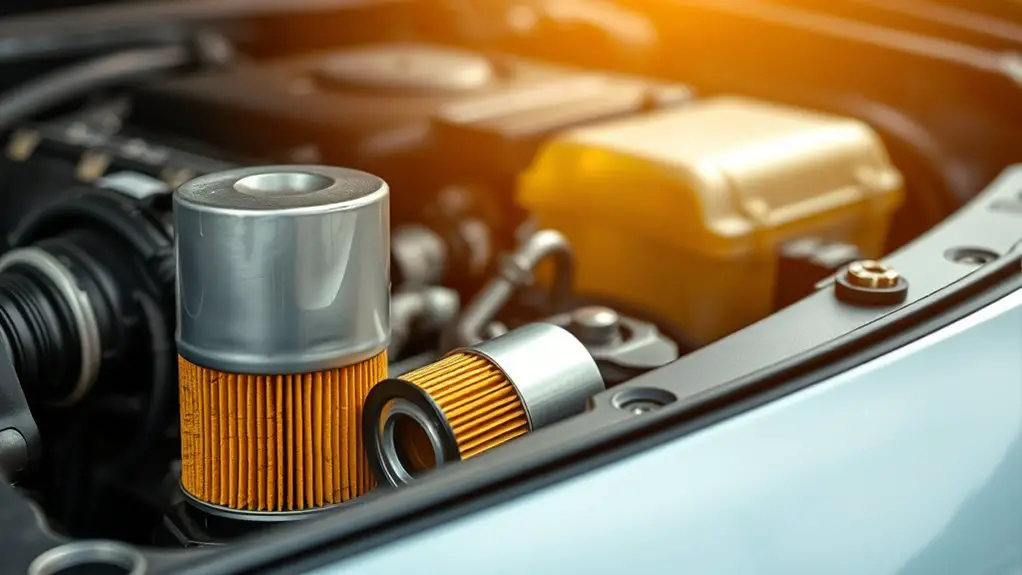
Regular oil changes and filter care are foundational for sustaining engine efficiency. You’ll approach maintenance with a systematic mindset, outlining intervals, measurements, and outcomes instead of guesswork. Think of oil viscosity as the engine’s lifeline: correct viscosity minimizes internal friction, sustains lubrication film strength, and supports stable operating temperatures. Track your vehicle’s manual-recommended grade, climate influences, and duty cycle to avoid over- or under-lubrication. When you perform oil changes, you’ll also assess oil color, viscosity consistency, and level accuracy to verify performance rather than assume it’s fine.
Filter replacement matters just as much as the fluid itself. A clean oil filter reduces particulates and pressure drop, preserving pump efficiency and engine longevity. Document your change dates, oil type, and filter part number for traceability. Use quality filters and proper torque specifications to prevent leaks. By adhering to precise schedules and verifying results, you maintain ideal fuel economy and reliable power delivery.
Air Filter Maintenance for Better Airflow
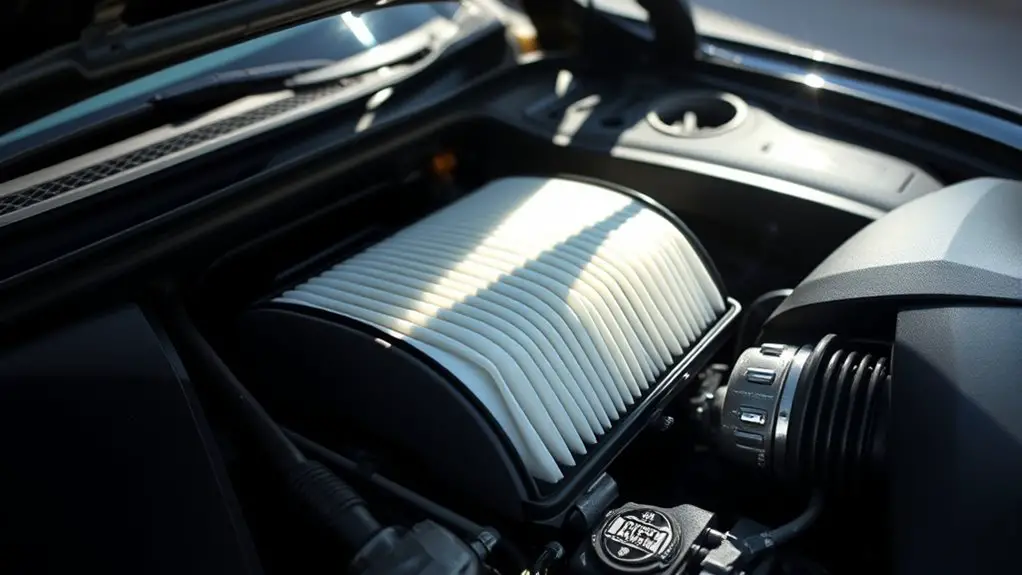
Air filter maintenance directly affects how efficiently your engine breathes, so after solidifying oil and filter practices you’ll apply the same systematic approach to airflow. You’ll assess filter condition, fit, and replacement intervals with clear criteria, avoiding guesswork. Begin by identifying air filter types in your vehicle—panel, cylindrical, or pleated—then confirm compatibility with the intake system. Inspect for dirt, debris, and seal integrity, and replace if resistance or visible contamination exceeds recommended limits. Document maintenance timing based on driving conditions, environment, and mileage to prevent overdue replacements. A clean filter reduces intake restrictions, stabilizes idle, and supports steady airflow, delivering tangible airflow benefits such as improved throttle response and consistent fuel-air ratio. Additionally, maintain housing cleanliness to prevent bypass leaks. Track performance indicators like MPG and power delivery after each service, adjusting intervals as needed. This disciplined approach preserves engine efficiency without sacrificing freedom or driving enjoyment.
Tire Maintenance: Pressure, Alignment, and T Tread
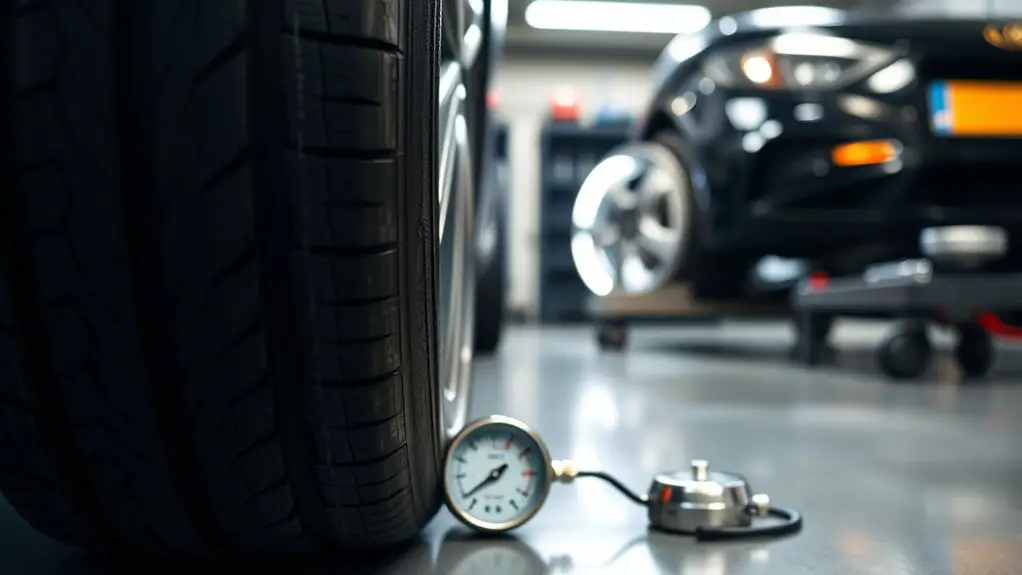
To optimize fuel efficiency, you’ll start with precise tire pressure, ensuring it matches the vehicle’s spec and remains consistent across all tires. Next, assess alignment and tread wear to detect uneven fatigue that can waste power and reduce grip. By systematically documenting tire pressures, alignment indicators, and tread depth, you set a clear baseline for ongoing maintenance.
Tire Pressure Check
Maintaining proper tire pressure is a precise, repeatable task that directly affects fuel efficiency, handling, and tire longevity. You’ll check cold tires, reference the manufacturer’s spec, and adjust with steady pressure. Underinflation wastes fuel; overinflation reduces grip and uneven wear. Measure with a reliable gauge, then verify at least once a month and before long trips. After adjustment, recheck all tires for uniform pressure and listen for subtle vibrations that signal imbalance. Document readings for trend analysis and future comparisons. Incorporate tire rotation and monitor tread depth to sustain performance without compromising safety. Table provides a concise view of pressures, actions, and checks.
| Item | Action/Note |
|---|---|
| Target Pressure | Set when cold; recheck after seating bead if needed |
| Verification | Confirm all tires within spec and note changes |
Alignment and Tread
After ensuring proper tire pressure, alignment and tread become the next focal points for sustained fuel efficiency and safety. You’ll inspect alignment by noting steering pull, vibrations, and uneven tire edges toward tread wear, then verify suspension health and camber, toe, and caster as needed. Misalignment increases rolling resistance, compromising fuel economy, so small, timely corrections matter. For tread, assess depth with a gauge and watch for cupping, feathering, or sidewall checks that signal suspension or alignment issues. Schedule tire rotation per manufacturer guidance to promote even wear and prolong grip. Track tread wear patterns across all tires to confirm balanced contact with the road. Maintain consistent tire spacing around the circumference, ensuring wheels roll true and pressure remains stable after adjustments.
Spark Plugs and Ignition System Maintenance
Spark plugs and the ignition system are critical for efficient combustion, consistent engine performance, and ideal fuel economy. You’ll assess electrode condition, gap accuracy, and plug type to predict spark reliability. Focus on spark plug performance by inspecting wear, fouling, and carbon buildup, then determine if replacement or re-gapping is necessary. Systematically test ignition coils, spark plug wires, and connectors for resistance, cracks, and misfires, as faults here directly degrade combustion efficiency. You’ll correlate ignition timing with engine load and RPM, verifying timing marks and using a diagnostic tool to detect retarded or advanced timing trends. If timing is off, fuel economy suffers due to incomplete combustion and elevated emissions. Maintain proper ignition system grounding and clean connections to prevent parasitic losses. Document service intervals and component ages to establish a preventive cadence. Prioritize high-quality plugs and correct heat range for your engine to sustain consistent performance and fuel efficiency.
Fluid Checks and Coolant System Health
Fluid checks and coolant system health are foundational to consistent engine performance and fuel efficiency. You’ll approach this systematically: verify coolant condition, level, and mix ratio first, then inspect hoses, caps, and reservoirs for leaks or signs of wear. Start with coolant checks: check the color, clarity, and odor; any haziness or metallic scent signals contamination or breakdown, prompting testing or replacement. Confirm coolant levels while the engine is cold, ensuring the‑fill line is within the recommended range. Record observed deviations and plan corrections before a trip. Next, assess the cooling system’s integrity: look for cracks, loose clamps, and swollen hoses; listen for abnormal sounds when the radiator cap is removed. Maintain proper fluid levels, topping with the recommended antifreeze solution if needed, never mixing incompatible products. A disciplined routine reduces heat‑related efficiency losses and guards against overheating, reinforcing preventive maintenance and reliable fuel economy over time.
Drive Habits and Identification of Fuel-Saving Upgrades
You’ll assess how Efficient Driving Habits impact fuel use by mapping daily routines to measurable savings and identifying where small changes yield the biggest gains. Consider Fuel-Saving Upgrades and how they complement your driving pattern, from tires to engine software, prioritizing evidence-based options. Finally, you’ll pinpoint Improvement Opportunities by analyzing past trips, corroborating findings with data, and outlining concrete next steps.
Efficient Driving Habits
Efficient driving habits combine consistent technique with quick, informed choices about vehicle upgrades; by systematically evaluating how you drive and what you upgrade, you can steadily improve fuel economy without sacrificing safety or comfort. You assess your baseline patterns: acceleration, braking, lane position, and route choice, then map concrete, repeatable adjustments. Eco friendly driving hinges on maintaining steady speeds, anticipating traffic, and minimizing hard accelerations, while speed management emphasizes staying within realistic limits and using cruise when appropriate. You treat maintenance as a driver skill: tire pressure, engine load, and transmission behavior all influence efficiency. Prioritize habits that reduce drag, optimize gearing, and avoid unnecessary idling. This disciplined approach preserves freedom by enhancing performance, reliability, and cost savings.
Fuel-Saving Upgrades
To identify meaningful fuel-saving upgrades, start with a structured assessment of both drive habits and vehicle systems, then categorize potential changes by impact, cost, and feasibility. You’ll compare how you operate the car with how components perform, separating high-value gains from marginal tweaks. Prioritize options that align with your goals for freedom and efficiency while keeping risk low. Focus on concrete, evaluative steps: quantify expected fuel savings, certify implementation effort, and plan phasing. Consider engine tuning as a lever to optimize combustion efficiency within safe limits, and weigh weight reduction opportunities if they meaningfully affect rolling resistance without compromising safety or load needs. Document the rationale for each upgrade, and verify compatibility with your model’s specifications and maintenance schedule.
Identifying Improvement Opportunities
Identifying Improvement Opportunities begins with a clear map of both driver behavior and vehicle systems, so you can target high-impact changes without overhauling your setup. You’ll systematically catalog habits that affect fuel consumption, then pair them with measurable engine performance indicators. Track accelerations, cruising speeds, idle durations, and braking patterns, linking each to fuel use and wear. Evaluate maintenance gaps—spark plugs, air filters, tires, and lubrication—that constrain efficiency. Identify upgrades that yield the best return, such as transmission timing, exhaust flow, or ECU tuning, but prioritize fixes that improve drivability and freedom, not just numbers. Use data dashboards to compare before-and-after results, ensuring changes are repeatable and scalable. Your disciplined approach clarifies opportunities, aligns actions with performance targets, and sustains long-term fuel efficiency gains.
Frequently Asked Questions
How Do Weather Changes Affect Preventive Maintenance Schedules?
Weather changes influence preventive maintenance schedules through seasonal adjustments and temperature effects. You’ll tighten inspection cadences when extreme heat or cold increases wear, and you’ll adjust fluid change intervals as temperatures shift viscosity and volatility. You should monitor battery health, tire pressure, and coolant quality more frequently during shifting periods. By analyzing trends, you’ll synchronize maintenance timing with forecasted conditions, ensuring reliability while preserving efficiency, adaptability, and your freedom to operate under varying climates.
What Role Do Gasoline Additives Play in Fuel Efficiency?
Gasoline additives can improve fuel performance by cleaning deposits, stabilizing fuel, and boosting octane where needed, though benefits vary by engine and fuel quality. You’ll want to choose additives that match your vehicle’s specs and follow recommended doses. Skeptics may worry about cost, but disciplined use often yields smoother operation and marginal efficiency gains. You, seeking freedom, can weigh proven formulations, monitor performance, and avoid overuse that could harm lubricants or sensors.
How Often Should Battery Health Be Checked for Fuel Savings?
You should check your battery health every 6 months or 6,000 miles, whichever comes first. This cadence supports clear maintenance intervals and keeps you informed about battery lifespan, helping you optimize fuel savings. You’ll assess voltage, cold-cranking amps, and parasitic draw methodically, documenting results. If readings drift, adjust usage or replace components promptly. You’ll maintain performance through disciplined checks, ensuring reliability without sacrificing your freedom to explore.
Can Aerodynamics and Underbody Cleanliness Impact Efficiency?
Sure, your car’s aerodynamics and underbody cleanliness absolutely impact efficiency. You’ll notice smoother airflow from good aerodynamic design, and fewer drag-inducing deposits with regular underbody maintenance. Ironically, neglecting them is like shouting into the wind about fuel savings. You should assess airflow, wheeltracking, and clean undercarriage surfaces, then incorporate streamlined components and periodic debris removal. Systematically monitor drag coefficients, verify seals, and plan routine maintenance to sustain peak efficiency and freedom to drive.
What Impact Does Cabin Air Filter Replacement Have on Mpg?
Replacing your cabin air filter can marginally affect mpg by ensuring ideal airflow and reducing engine strain, though the impact is typically small. When you swap the cabin filter on schedule, you help maintain interior air quality and prevent clogged vents that could indirectly tax the system. You should monitor engine performance for subtle improvements, as a clean cabin filter supports consistent intake efficiency, and consider routine checks of cabin filter and related components.

